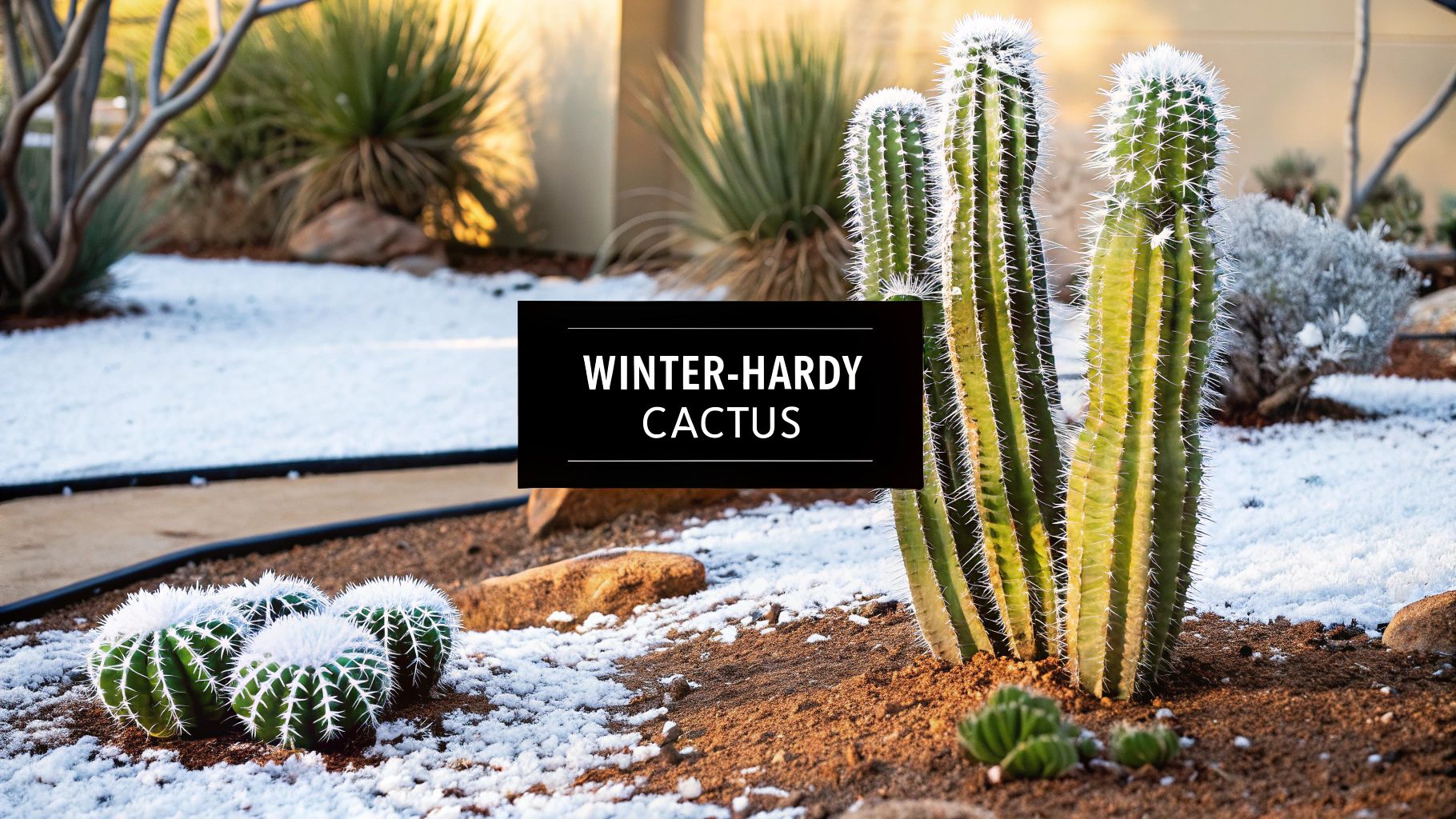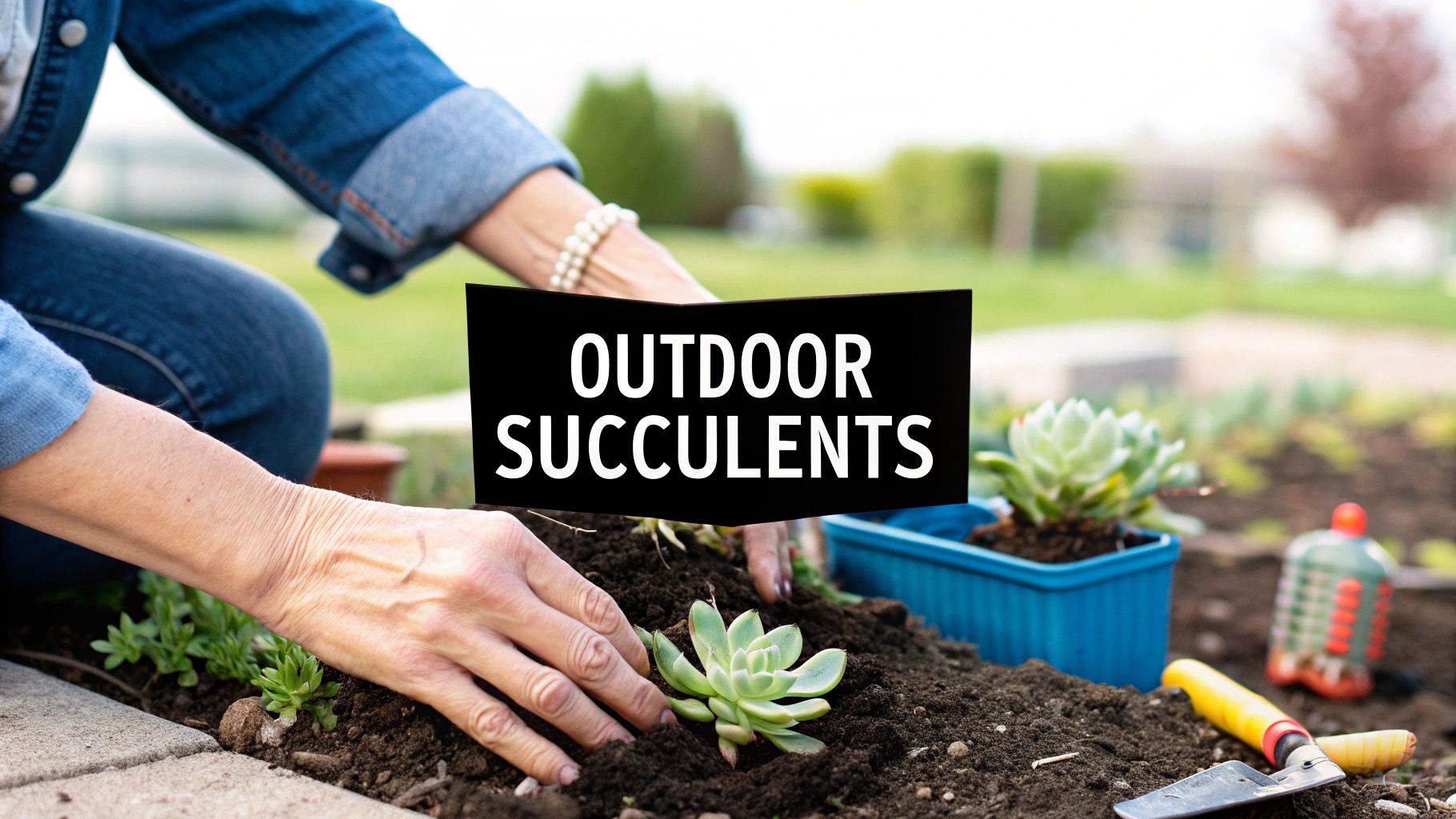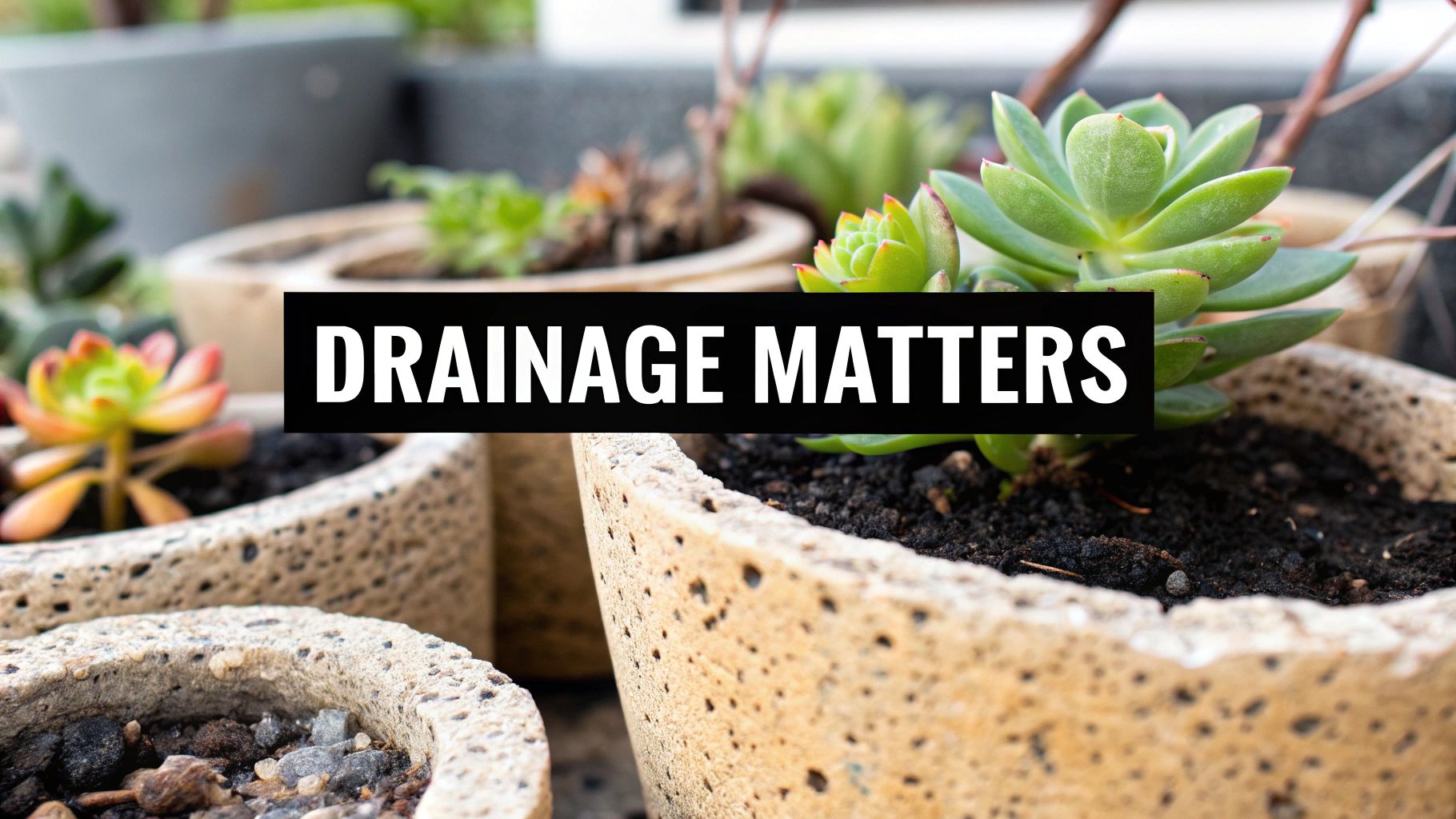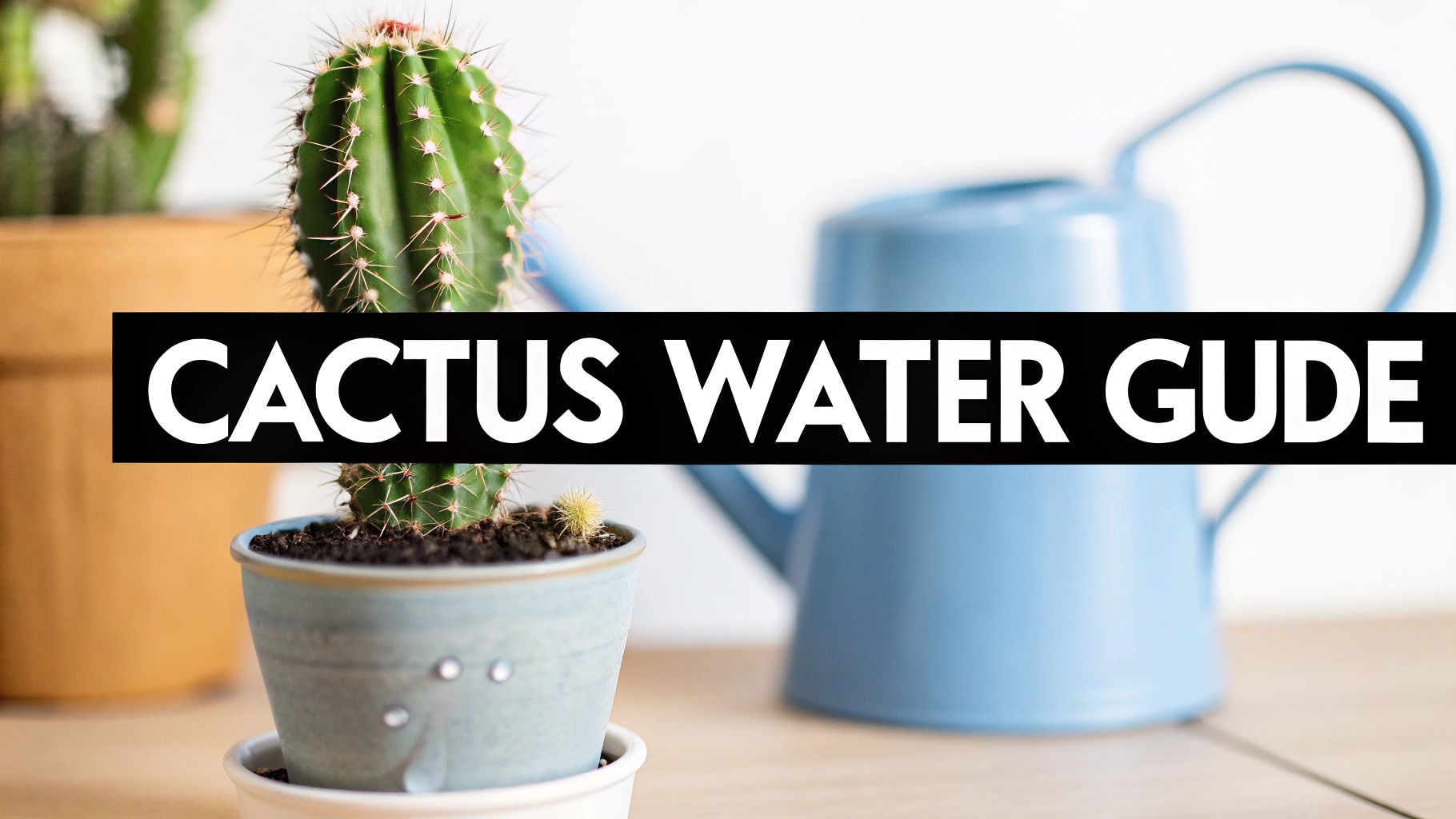When most people think of cacti, they picture scorching deserts and relentless sun. The idea of a cactus covered in snow seems almost impossible, doesn't it? But it’s true. A cactus that can survive winter isn't a gardener's fantasy—it's a real and surprisingly tough group of plants.
These aren't just desert dwellers that can tough out a chilly night. They are specialized survivors, often called cold-hardy cacti, built from the ground up to handle freezing temperatures and snowy landscapes.
Challenging the Desert-Only Cactus Myth

Let's be honest, the image of a cactus is deeply tied to arid, sun-baked environments. It's the classic symbol of the American Southwest. So, seeing one dusted with snow feels completely out of place.
But this common picture leaves out a whole family of incredibly resilient plants. Many species are native to high-altitude regions or northern plains where frigid winters are the norm. A cactus that can survive winter has developed clever biological tricks to deal with conditions that would kill its desert cousins. They are true masters of survival.
The Secret to Winter Survival
So, what's their secret? How can a plant known for storing water possibly survive a hard freeze?
It all comes down to managing that water. As the days get shorter and colder in the fall, these cacti know it's time to prepare. Their strategy is beautifully simple: they start to dehydrate themselves on purpose.
By pushing water out of their cells, they dramatically lower the freezing point of the fluid left inside. It’s a lot like how antifreeze works in your car’s engine. Less water means the remaining sap is a more concentrated solution of sugars and salts, which resists freezing. This is why you'll often see hardy cacti look a little shriveled, deflated, or even change color in the winter—it’s a sign they’re in full-on survival mode.
This controlled dehydration is the most critical adaptation for a cactus that can survive winter. It concentrates the sugars and salts within the cells, creating a natural antifreeze that protects the plant's delicate tissues from bursting in freezing temperatures.
Once you grasp this idea, winter care for these cacti makes perfect sense. It’s not about keeping them warm; it's about keeping them dry. Wet, frozen soil is their number one enemy—far more dangerous than the cold air itself. With the right plant and excellent drainage, you can bring a surprising and beautiful piece of the desert to your own cold-climate garden.
Understanding Climate Zones for Hardy Cacti

Before you can pick the right cactus that can survive winter, you need to get a handle on your local climate. The single most useful tool for this is the USDA Plant Hardiness Zone Map.
Think of this map as the definitive guide for gardeners. It carves up the country into 13 distinct zones, and each one is based on a single, critical piece of information: the average lowest winter temperature. Every zone represents a 10-degree Fahrenheit difference, giving you a clear picture of just how cold your winter nights can get.
It's pretty straightforward: the lower the zone number, the colder the winter. A cactus that's hardy to Zone 5, for instance, is tough enough to handle brutal lows between -20°F to -10°F. On the other hand, a plant rated for Zone 9 can only reliably survive dips down to 20°F. Knowing your zone is, without a doubt, the first step in this whole process.
What Is Your Hardiness Zone?
Finding your zone is easy, and it’s the key to your success. A quick search online with your zip code will tell you everything you need to know. That one number immediately filters your options, pointing you toward plants that are built to thrive where you live. Always aim for a cactus rated for your zone or colder—this gives it the best possible shot at making it through the winter.
If you're looking for more details on getting your garden beds ready, our guide on planting succulents outside has some fantastic advice that works just as well for hardy cacti, especially when it comes to soil and placement.
A plant's hardiness rating is its survival promise. A Zone 5 cactus planted in a Zone 5 garden has the tools to endure the winter, while a Zone 9 cactus in the same garden is simply not equipped for the extreme cold and will likely perish.
Beyond the Map: Microclimates and Moisture
Your official zone gives you the big picture, but it’s not the whole story. Every yard has its own unique "microclimates"—little pockets that are slightly warmer or colder than the general area.
- South-Facing Walls: A spot right up against a south-facing wall will soak up sun all day and radiate that heat back out, often creating a microclimate that feels a full zone warmer.
- Sheltered Corners: Any spot protected from whipping winter winds is going to be a much cozier place for a plant than a wide-open, exposed location.
- Low-Lying Spots: Cold air is heavy. It sinks and settles in the lowest parts of your garden, making those spots frostier and often wetter.
Here's the real secret, though: for a cactus to make it through the winter, staying dry is just as important as the temperature. Soggy, frozen soil is a cactus killer. A plant can shrug off incredibly cold air if its roots are dry, but if they're stuck in icy mud, they’ll rot in no time. This is why excellent drainage is completely non-negotiable. It’s the final piece of the puzzle that unlocks their amazing resilience.
Finding The Best Prickly Pear Cacti For Cold Climates
When you start looking for a cactus that can actually handle a real winter, one name pops up again and again: the Prickly Pear, or Opuntia. This is an incredibly diverse group, famous for its flat, paddle-like segments (technically called cladodes) and its sheer toughness. While most people picture cacti in sun-scorched deserts, the Opuntia genus is a goldmine for gardeners in cold climates.
These plants don’t just survive the cold; they've mastered it. Their secret is a fascinating bit of plant biology. As winter sets in, they deliberately dehydrate themselves, pulling water out of their paddles. This makes them look a little shriveled and limp, but it’s a brilliant defense mechanism. Less water means ice crystals can't form and shred their cell walls from the inside out, allowing them to withstand a deep freeze.
A Colorful And Tough Contender
One of the most impressive examples has to be Opuntia fragilis, also known as the Brittle Prickly Pear. It lives up to the name—its small pads break off easily, which is actually a clever way for it to spread and root new plants. But its real claim to fame is its mind-boggling cold tolerance. This little cactus can handle temperatures plummeting as low as -30°F, making it a rock-solid choice for gardens in some of the coldest parts of the country.
Beyond just surviving, many Prickly Pears put on a spectacular show. Several species in the Opuntia genus can thrive in USDA zones as low as 4 or 5, where winter temperatures routinely drop below -20°F (-28.9°C). A great example is Opuntia 'Piña Colada', a hybrid that’s happy down to about -20°F and grows well in zones 5 through 9. It typically reaches about 2 feet tall and spreads to 6 feet wide, but what really makes it stand out are its paddles—they turn a stunning reddish-purple during cold snaps.
This dramatic color change is a direct response to cold and drought stress, a beautiful sign that the plant is actively protecting itself. If you're new to growing these amazing plants, our guide on how to grow a prickly pear cactus will help you get started on the right foot.
Comparing Popular Cold-Hardy Prickly Pear Cacti
Choosing the right Opuntia can feel overwhelming, but seeing their key features side-by-side makes it much easier. This table breaks down a few of the most popular and reliable options for chilly gardens.
| Species Name | USDA Hardiness Zone | Minimum Temperature | Mature Size | Key Feature |
|---|---|---|---|---|
| Opuntia fragilis (Brittle Prickly Pear) | 4a | -30°F | 6" H x 2' W | Extremely cold tolerant; small, easily detached pads. |
| Opuntia humifusa (Eastern Prickly Pear) | 4a | -30°F | 1' H x 3' W | Very adaptable; produces bright yellow flowers. |
| Opuntia 'Piña Colada' | 5a | -20°F | 2' H x 6' W | Paddles turn a vibrant reddish-purple in winter. |
| Opuntia polyacantha (Plains Prickly Pear) | 4b | -25°F | 1' H x 4' W | Densely spined; highly drought and cold resistant. |
Each of these brings something unique to the landscape, from incredible hardiness to stunning winter color. The key is matching the species to your specific zone and aesthetic goals.
Setting Them Up For Success
Even the most bulletproof Prickly Pear needs one thing to survive a cold winter: excellent drainage. Cold, wet soil is a cactus killer, far more dangerous than cold air alone. To give your plant its best shot, you have to create a soil environment that sheds water fast, preventing ice from forming around its roots.
This infographic lays out the ideal soil recipe for a happy, winter-hardy cactus.

As you can see, the mix is heavy on inorganic materials like sand and perlite. This is intentional—it ensures that water never has a chance to pool around the plant’s sensitive root system.
The golden rule for winter cactus survival is simple: Dry roots are happy roots. No matter how cold the air gets, a cactus with dry feet has a fighting chance.
By picking a proven winner from the Opuntia family and giving it the sharp drainage it demands, you can add dramatic, year-round structure and surprising pops of color to your cold-climate garden.
A Look at Other Tough Cactus Varieties

While Prickly Pears often steal the spotlight, the world of cold-hardy cacti is wonderfully diverse. Once you look past the iconic paddles of Opuntia, you'll find an amazing collection of barrel, clumping, and ball-shaped cacti that are every bit as tough. These species prove you don’t have to sacrifice unique forms and stunning flowers for winter resilience.
Many of these lesser-known gems have adapted to survive in some seriously harsh climates, from high-altitude mountains to windswept northern prairies. Their compact, low-to-the-ground shapes are a key part of their survival strategy. A small, rounded form is less exposed to damaging winter winds and is brilliant at shedding snow, which keeps the plant from getting crushed or encased in ice.
The Tough and Beautiful Echinocereus Genus
One of the standout groups for any cold-climate garden is the Echinocereus genus, better known as Hedgehog Cacti. This family is packed with species that combine intricate beauty with serious grit. Gardeners love them for their vibrant, oversized flowers that burst onto the scene in spring, often in dazzling shades of pink, magenta, and red.
One of the toughest members of this family is the Lace Cactus (Echinocereus reichenbachii), which can shrug off temperatures as low as -25°F (-31.7°C). It thrives in USDA hardiness zones 4 and 5, making it a reliable choice for many northern gardens that see severe winters. Despite its small stature—it rarely grows over a foot tall—it boasts dense, elegant white spines and produces beautiful pale pink flowers in early summer. You can find more on its impressive hardiness in a piece from the Brooklyn Botanic Garden.
Other notable members of this genus include:
- Echinocereus viridiflorus (Green Pitaya): Known for its unique greenish-yellow flowers and its ability to handle temperatures down to -20°F. It's one of the most widespread and variable species out there.
- Echinocereus triglochidiatus (Claret Cup Cactus): Famous for its brilliant scarlet-red, cup-shaped flowers. Certain varieties of this species are hardy down to Zone 5.
These cacti typically form attractive clumps over time, creating a wonderful textured mound in a rock garden or raised bed. There’s something special about seeing them produce such spectacular flowers after enduring a harsh winter—it makes them especially rewarding to grow.
Prairie Survivors: The Escobaria Genus
For the ultimate test of endurance, you have to look at the Escobaria genus. These aren't just cacti that can survive winter; they are true arctic survivors native to the North American prairies and Rocky Mountains. They are often small, clumping, and covered in dense spines that provide an extra layer of insulation from the cold.
These prairie natives are masters of dormancy. Their ability to shrink and dehydrate in preparation for winter is extreme, allowing them to endure conditions that would kill almost any other cactus.
Two of the most resilient species are Escobaria missouriensis and Escobaria vivipara. Both are hardy to at least USDA Zone 4, with some populations reportedly surviving even colder conditions. They are small, unassuming plants for much of the year but reward the patient gardener with stunning pink or yellow flowers in the spring. Their compact size makes them perfect for tucking into tight spaces in a rock garden, where they'll quietly withstand the worst of winter.
By exploring these genera, you open up a whole new palette of shapes, textures, and colors for your cold-climate landscape.
Perfecting Your Winter Cactus Care Routine
Getting a cactus that can survive winter to actually thrive is less about fighting the cold and more about mastering moisture. Sure, you have to start with a cold-hardy species, but it's your care routine—especially in the fall—that truly sets it up for success. Think of it as helping your cactus prepare for a long winter nap.
The single most important factor is drainage. I can't stress this enough. Cold, wet soil is the absolute number one killer of a wintering cactus. When water hangs around the roots and freezes, it's game over. That ice will cause fatal rot, no matter how tough the plant is. Your primary mission is to create a spot where water vanishes almost instantly.
Build the Perfect Cactus Bed
To keep your cactus high and dry, you’ll need to create the perfect soil environment. This usually means either heavily amending your existing garden soil or, even better, building a dedicated bed for them.
- Soil Mix is Key: Your average garden soil holds way too much water. You need to create a super gritty mix. A good starting point is about 60% coarse sand or fine gravel, 30% potting soil, and 10% perlite. This recipe forces water to drain right through, leaving no time for it to get waterlogged.
- Location Matters: Plant your cacti on a natural slope or in a raised bed. Using elevation is like a cheat code; gravity does all the work, pulling water away from the plant’s sensitive root zone and keeping its base dry. A south-facing slope is the gold standard because it also gets the most sun.
The goal is to mimic the arid, rocky conditions where these plants evolved. In their native habitats, water arrives and disappears quickly, never lingering around the roots. Replicating this is the secret to winter survival.
The Importance of a Dry Winter Dormancy
Now for the part that feels completely wrong: you have to stop watering your cacti. This isn't neglect, it's a critical step that activates their natural survival instincts.
As temperatures start to drop in late summer or early fall, cut off all supplemental watering. This is the signal that tells the cactus winter is on its way, triggering it to start dehydrating its own cells. This process concentrates the sugars inside its tissues, which acts like a natural antifreeze to prevent damaging ice crystals from forming. Our guide on watering cactus plants dives deeper into the seasonal needs of these plants.
This dehydration is exactly why a healthy wintering cactus might look a little shriveled or even change color. That's a good sign! It means it’s properly prepped for a freeze. It's fascinating how cacti from completely different parts of the world have developed similar strategies. For instance, certain South American species from the Gymnocalycium and Maihuenopsis genera can handle snowy USDA zone 7 winters, but only if they are kept bone-dry. You can find more insights on South American cold-hardy cacti and their surprising resilience.
By giving them perfect drainage and enforcing a strict dry dormancy, you're handing your cactus all the tools it needs to push through even the harshest weather.
Got Questions About Your Winter Cacti? We've Got Answers
Even with a good plan, stepping into the world of cold-climate cactus gardening can feel a little intimidating. It's one thing to read about it, but it’s another thing entirely when you see your prized cactus that can survive winter start looking a bit sad as the first frost looms. Don't worry, that's completely normal. Let's walk through some of the most common questions and concerns.
"Help! My Hardy Cactus Looks Like a Wrinkled Mess!"
Seeing your outdoor cactus suddenly look deflated, limp, or even a weird purple-ish color as winter sets in can definitely send you into a panic. Your first thought might be that it's dying. But take a deep breath—what you're seeing is actually a sign of a very healthy plant doing exactly what it's supposed to.
This shriveling is a brilliant survival tactic. The cactus is actively pushing water out of its cells, which concentrates the remaining sugars and salts. This essentially creates a natural antifreeze, lowering the freezing point of the fluid left in its tissues. Without this step, those cells would freeze, expand, and rupture, causing fatal damage. A plump, water-logged cactus is a ticking time bomb in a hard freeze.
A shriveled winter cactus is a successful winter cactus. Its wrinkled, almost lifeless appearance is your proof that it has gone dormant and is ready for whatever freezing temperatures come its way. It's a visual cue that its internal biology is working perfectly.
So, whatever you do, fight the urge to give it a drink. It isn’t thirsty; it’s just armoring up for the cold. Come spring, when the weather warms and the rains return, it will naturally plump right back up.
"Can I Keep Winter-Hardy Cacti in Pots?"
Absolutely! In fact, growing a winter-hardy cactus in a container is a fantastic choice, especially if your native garden soil is heavy clay or if you're just short on space. But you can't just pot it and forget it—growing in containers requires a few key adjustments because pots are far more exposed to the elements than the ground.
Think about it: the soil in a pot will freeze solid way faster and deeper than garden soil, which gets a little help from the earth's insulating warmth. This exposure makes your care choices that much more important.
To keep a potted cactus happy and alive through the winter, you need to nail three things:
- Wicked-Good Drainage: Your pot must have plenty of large drainage holes. Water can never, ever be allowed to pool at the bottom.
- A Super Gritty Mix: Forget standard potting soil. You need a blend that's at least 60-70% inorganic grit like pumice, coarse sand, or fine gravel. The goal is for water to pour right through it.
- Total Rain Protection: This is the big one. You have to move the pot to a spot where it will stay bone-dry all winter. A covered porch, under the eaves of your house, or in a dedicated rain shadow will work perfectly. Winter wet is the enemy, not the cold itself.
"What Are the Biggest Mistakes I Should Avoid?"
After years of helping people grow these amazing plants, I can tell you that most failures come down to just a handful of common—and totally avoidable—mistakes. Knowing what not to do is half the battle.
The number one killer, by a long shot, is poor drainage. Soggy soil plus freezing temperatures equals rotted roots, and there’s no coming back from that. Right behind that is choosing the wrong spot—planting in a low-lying area where cold air and moisture settle is setting your cactus up for failure.
Finally, getting your timing wrong can be a fatal mistake. If you water or fertilize too late in the fall, you encourage the plant to produce soft, new growth that hasn't had a chance to "harden off" before the first big freeze. As a rule of thumb, stop all water and fertilizer by late summer. This gives your cactus plenty of time to slow down and get ready for its long winter nap. If you can sidestep these simple pitfalls, you're well on your way to success.
Ready to add some year-round architectural beauty to your garden? At The Cactus Outlet, we offer a stunning selection of robust and beautiful cacti perfect for any landscape. Explore our collection and find the perfect plant to start your cold-climate cactus journey today. Find your next favorite plant at https://www.cactusoutlet.com.




